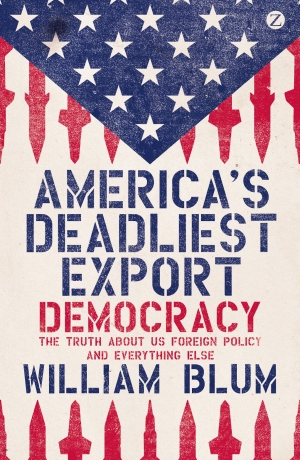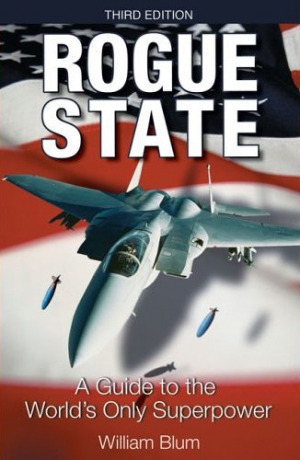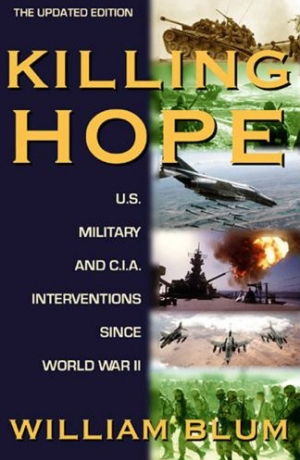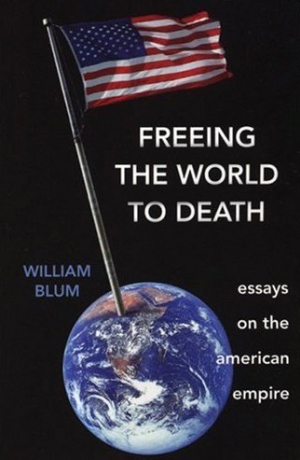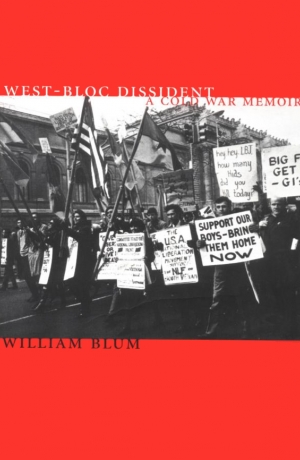Cuban Political Prisoners ... in the United States
By William Blum
The Florida Association of Criminal Defense Lawyers gave the defense team its “Against All Odds” award, established in honor of a deceased public defender who championed hopeless causes. 1
Defending pro-Castro Cubans in Miami, in a criminal case utterly suffused with political overtones, with the US government wholly determined to nail a bunch of commies, is a task on a par with conducting a ground war with Russia in the wintertime.
Even in the absence of known anti-Castro Cuban exiles on the jury, the huge influence the exiles have on the rest of the community is an inescapable fact of life in Miami, a place where the sound of the word “pro-Castro” does what the word “bomb” does at an airport.
President Bush has assured the world repeatedly that he will not heed the many calls to lift the Cuban trade embargo unless Fidel Castro releases what Washington calls “political prisoners”. Bush tells us this while ten Cubans sit in US prisons, guilty essentially of not being the kind of Cubans George W. loves. If a political prisoner can be defined as one kept in custody who, if not for his or her political beliefs and/or associations would be a free person, then the ten Cubans can be regarded as political prisoners.
It all began in September 1998 when the Justice Department accused 14 Cubans in southern Florida of “conspiracy to gather and deliver defense information to aid a foreign government, that is, the Republic of Cuba” and failing to register as agents of a foreign government. 2 Four of the accused were never apprehended and are believed to be living in Cuba. Five of the 10 arrested, having less than true-believer faith in the American- judicial-system, copped plea bargains to avoid harsher penalties and were sentenced to between three and seven years in prison.
The US Attorney said the actions of the accused – who had been under surveillance since 1995 – were an attempt “to strike at the very heart of our national security system and our very democratic process”. 3 Their actions, added a judge, “place this nation and its inhabitants in great peril”. 4
Such language would appear more suitable for describing the attacks of September 11, 2001 than the wholly innocuous behavior of the accused. To add further to the level of melodrama: in the Criminal Complaint, in the Indictment, in public statements, and in the courtroom, the federal government continuously squeezed out as much mileage as it could from the fact that the Cubans had gone to meetings and taken part in activities of anti-Castro organizations – “duplicitous participation in and manipulation of” these organizations is how it was put. 5 But this was all for the benefit of media and jury, for there is obviously no law against taking part in an organization you are unsympathetic with; and in the end, after all the propaganda hoopla, the arrestees were never charged with any such offense.
The Cubans did not deny their activities. Their mission in the United States was to act as an early warning system for their homeland because over the years anti-Castro Cuban exiles in the US have carried out literally hundreds of terrorist actions against the island nation, including as recently as 1997 when they planted bombs in Havana hotels. One of the exile groups, Omega 7, headquartered in Union City, New Jersey, was characterized by the FBI in 1980 as “the most dangerous terrorist organization in the United States”. 6
Some exiles were subpoenaed to testify at the trial, which began in December 2000, and defense attorneys threw questions at them about their activities. One witness told of attempts to assassinate Fidel Castro and of setting Cuban buses and vans on fire. Based on their answers, federal prosecutors threatened to bring organized crime charges against any group whose members gave incriminating testimony and the Assistant US Attorney warned that if additional evidence emerged against members of Alpha 66, considered a paramilitary organization, the group would be prosecuted for a “long-standing pattern of attacks on the Cuban government.” 7 Cuba has complained for many years that US authorities ignore information Havana makes available about those in the US it claims are financing and plotting violence. 8 None of the exiles who testified at the trial about terrorist actions or the groups they belonged to were in fact prosecuted.
The arrested Cubans were involved in anti-terrorist activities – so cherished by the government of the United States in word – but were acting against the wrong kind of terrorists. Some of what they uncovered about possible terrorist and drug activities of Cuban exiles – including information concerning the 1997 hotel bombings – they actually passed to the FBI, usually delivered via diplomats in Havana. This presumably is what lay behind the statement in the Criminal Complaint that the defendants “attempted manipulation of United States political institutions and government entities through disinformation and pretended cooperation” 9 – i.e., putting every action of the Cuban defendants in the worst possible light.
One of the Cubans, Antonio Guerrero, was employed as a manual laborer at the US naval base in Boca Chica, Florida, near Key West. The prosecution stated that Guerrero had been ordered by Cuba to track the comings and goings of military aircraft in order to detect “unusual exercises, maneuvers, and other activity related to combat readiness”. 10 Guerrero’s attorney, to emphasize the non-secret nature of such information, pointed out that anyone sitting in a car on US 1 could easily see planes flying in and out of the base. 11
This particular operation of the Cuban agents is difficult to comprehend, for it is hard to say which was the more improbable: that the US government would undertake another attack against Cuba, or that these Cubans could get timely wind of it in this manner.
The FBI admitted that the Cubans had not penetrated any military bases and that activities at the bases were “never compromised”. “They had no successes,” declared an FBI spokesperson. The Pentagon added that “there are no indications that they had access to classified information or access to sensitive areas”. 12
These statements did not of course rise from a desire to aid the Cubans’ defense, but rather to assure one and all that the various security systems were impenetrable. But, in short, the government was admitting that nothing that could be termed “espionage” had been committed. Nevertheless, three of the defendants were charged with communicating to Cuba “information relating to the national defense of the United States … intending and having reason to believe that the same would be used to the injury of the United States.” 13
The FBI agents who closely surveilled the Cubans for several years did not seem worried about the reports the “espionage agents” were sending to Havana and made no attempt to thwart their transmission. Indeed, the FBI reportedly arrested the Cubans only because they feared that the group would flee the country following the theft of a computer and disks used by one of them, which contained information about their activities, and that all the FBI surveillance would then have been for nought. 14
Somewhat more plausibly, those arrested were each charged with “acting as an unregistered agent of a foreign government, Cuba.” Yet, in at least the previous five years, no one in the United States had been charged with any such offense 15 , although, given the broad definition in the law of “foreign agent”, the Justice Department could have undoubtedly done so with numerous individuals if it had had a political motivation as in this case.
In addition to the unregistered foreign agent charge, which was imposed against all five defendants, there was the ritual laundry list of other charges that is usually facile for a prosecutor to come up with: passport fraud, false passport application, fraudulent identification, conspiracy to defraud the United States, aiding and abetting one or more of the other defendants (sic), conspiracy to commit espionage, and furthermore tacked onto all five – conspiracy to act as an unregistered foreign agent.
There was one serious charge, which was levied eight months after the arrests against the alleged leader of the Cuban group, Gerardo Hernández: conspiring to commit murder, a reference to the February 24, 1996 shootdown by a Cuban warplane of two planes (of a total of three), which took the lives of four Miami-based civilian pilots, members of Brothers to the Rescue (BTTR). In actuality, the Cuban government may have done no more than any other government in the world would have done under the same circumstances. The planes were determined to be within Cuban airspace, of serious hostile intent, and Cuban authorities gave the pilots explicit warning: “You are taking a risk.” Indeed, both Cuban and US authorities had for some time been giving BTTR – which patrolled the sea between Florida and Cuba looking for refugees – similar warnings about intruding into Cuban airspace. 16
Jose Basulto, the head of BTTR, and the pilot of the plane that got away, testified at the trial that he had received warnings that Cuba would shoot down planes violating its airspace. 7 In 1995, he had taken an NBC cameraman on a rooftop-level flight over downtown Havana and rained propaganda and religious medals on the streets below, 18 the medals capable of injuring people they struck. Basulto – a long-time CIA collaborator who once fired powerful cannonballs into a Cuban hotel filled with people 19 – described one BTTR flight over Havana as “an act of civil disobedience”. 20 His organization’s planes had gone into Cuban territory on nine occasions during the previous two years with the pilots being warned repeatedly by Cuba not to return, that they would be shot down if they persisted in carrying out “provocative” flights. A former US federal aviation investigator testified at the trial that in the 1996 incident the planes had ignored warnings and entered an area that was activated as a “danger area”. 21
Also testifying was a retired US Air Force colonel and former regional commander of the North American Air Defense Command (NORAD), George Buchner. Citing National Security Agency transcripts of conversations between a Cuban battle commander on the ground and the Cuban MiG pilots in the air, he stated that the two planes were “well within Cuban airspace” and that a Cuban pilot “showed restraint” by breaking off his pursuit of the third plane as the chase headed toward international airspace.
Buchner’s conclusion was at odds with earlier analyses conducted by the United States and the International Civil Aviation Organization (which relied heavily on intelligence data provided by the US). However, he added that the three planes were acting as one and that Cuba was within its sovereign rights to attack them – even in international airspace – because the plane that got away had entered Cuban airspace, a fact not disputed by the prosecution or other investigators.
“The trigger,” said Buchner, “was when the first aircraft crossed the 12-mile territorial limit. That allowed the government of Cuba to exercise their sovereign right to protect its airspace.” He stated, moreover, that the BTTR planes had given up their civilian status because they still carried the markings of the US Air Force and had been used to drop leaflets condemning the Cuban government. 22
Two days after the incident, the New York Times reported that “United States intelligence officials said that at least one of the American aircraft – the lead plane, which returned safely to Florida – and perhaps all three had violated Cuban airspace.” United States officials agreed with the Cuban government that “the pilots had ignored a direct warning from the air traffic control tower in Havana”. 23
Hernández was charged with murder for allegedly giving Cuban authorities the flight plan of the planes flown by Brothers to the Rescue. 24 Even if true, the claim appears to be rather meaningless, for the Federal Aviation Administration (FAA) stated after the incident that after BTTR had filed its flight plan with their agency, it was then transmitted electronically to the air tower in Havana. 25 In any event, on that fateful day in February, when the three planes crossed the 24th parallel – the beginning of the area before entering Cuba’s 12-mile territorial limit, which the Cuban government, like other governments, defines as an air-defense identification zone – Basulto radioed his presence to the Havana Air Control Center and his intention to continue further south. Havana, which was already monitoring the planes’ flight, replied: “We inform you that the area north of Havana is activated [air defense readied]. You are taking a risk by flying south of twenty-four.” 26
Hernández was also accused of informing Havana, in response to a request, that none of the Cuban agents would be aboard the BTTR planes during the time period in question; one of them had flown with BTTR earlier. This too was equated in the indictment with “knowingly … to perpetrate murder, that is, the unlawful killing of human beings with malice aforethought”. 27
In the final analysis, the planes were shot down for entering Cuban airspace, for purposes hostile, after ignoring many warnings from two governments. After a January 13, 1996 BTTR overflight, Castro had issued orders to his Air Force to shoot down any plane that entered Cuban airspace illegally. 28 And just two weeks prior to the shootdown, a delegation of retired US officials had returned from Havana warning that Cuba seemed prepared to blow the Brothers’ Cessnas out of the sky. 29 Gerardo Hernández was not responsible for any of this, and there was, moreover, a long history of planes departing from the United States for Cuba to carry out bombing, strafing, invasion, assassination, subversion, weapon drops, agricultural and industrial sabotage, and other belligerent missions. 30 According to a former member of BTTR – who redefected to Cuba and may have been a Cuban agent all along – Basulto discussed with him ways to bring explosives into Cuba to blow up high tension wires critical to the country’s electrical system and plans to smuggle weapons into Cuba to use in attacks against leaders, including Fidel Castro. 31 At the time of the shootdown, Cuba had been under a 37-year state of siege and could never be sure what such enemy pilots intended to do.
Yet Hernández was sentenced to spend the rest of his life in prison. Ramón Labañino and Antonio Guerrero, the manual worker at the US naval base, were also sentenced to life terms; they and Hernández were all found guilty of conspiracy to commit espionage. Fernando González was put away for 19 1/2 years, and René González received 15 years. All five were convicted of acting as an unregistered agent of a foreign government as well as conspiracy – that great redundancy tool that is the lifeblood of American prosecutors – to do the same. All but one had the laundry list of identification frauds thrown at them.
For most of their detention since being arrested, the five men have been kept in solitary confinement. After their convictions, they were placed in five different prisons spread around the country – Pennsylvania, California, Texas, Wisconsin and Colorado – making it difficult for supporters and attorneys to visit more than one. The wife and five-year-old daughter of René González were denied visas to enter the United States from Cuba to visit him. Hernández’s wife was already at the Houston airport with all her papers in hand when she was turned back, although not before undergoing several hours of FBI humiliation.
The United States is currently engaged in a world-wide, open-ended, supra-legal campaign to destroy the rights of any individuals who – on the most questionable of evidence or literally none at all – might conceivably represent any kind of terrorist threat.
But if the Cubans – with a much longer history of serious terrorist attacks against them by well known perpetrators – take the most reasonable steps to protect themselves from further attacks, they find that Washington has forbidden them from taking part in the War Against Terrorism. This is particularly ironic given that the same anti-Castro exiles have committed numerous terrorist acts in the United States itself.
Notes
- Associated Press (AP), May 11, 2001
- US District Court, Southern District of Florida, case #98-3493, Criminal Complaint, September 14, 1998, “Conclusion” paragraph. Hereafter, “Criminal Complaint”.
- EFE News Service (based in Madrid, with branches in the US), March 28, 2001
- Miami Herald, September 18, 1998
- Criminal Complaint, paragraph 7
- New York Times, 3 March 1980, p. 1
- EFE News Service, March 28, 2001
- See for example Miami Herald, March 28, 2001, p.1B
- Criminal Complaint, paragraph 7; see also paragraph 26.
- Ibid., paragraph 19
- Miami Herald, September 23, 1998
- Washington Post, September 15, 1998; Miami Herald, September 16, 1998
- US District Court, Southern District of Florida, Case No. 98-721, Second Superseding Indictment, May 7, 1999, Count 2, Section D
- Miami Herald, September 16, 1998
- Department of Justice, Bureau of Justice Statistics, reported to author by John Scalia, statistician at the bureau.
- Associated Press, May 8, 2001
- EFE News Service, March 28, 2001
- Carl Nagin, “Backfire”, The New Yorker, January 26, 1998, p.32
- Jefferson Morley, “Shootdown”, Washington Post Magazine, May 25, 1997, p.120
- EFE News Service, February 1, 2001
- Ibid., March 1, 2001
- Associated Press, March 21, 2001; Miami Herald, March 22, 2001
- New York Times, February 26, 1996, p.1
- Associated Press, December 5, 2000
- New York Times, February 26, 1996, p.1. It is not clear from the article whether the transmission was made by the FAA or by BTTR
- The New Yorker, op. cit., p.34
- Second Superseding Indictment, see op. cit., Count 3, Section A
- The New Yorker, op. cit., p.33
- Newsweek, March 11, 1996, p.48
- Jane Franklin, Cuba and the United States: A Chronological History (Ocean Press, Australia, 1997), see index under “Planes used against Cuba”; William Blum, Killing Hope: US Military and CIA Interventions Since World War II (Common Courage Press, Maine, 1995), Cuba chapter
- Washington Post, February 27, 1996
